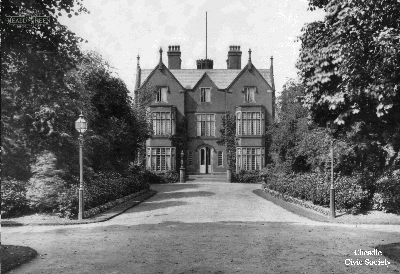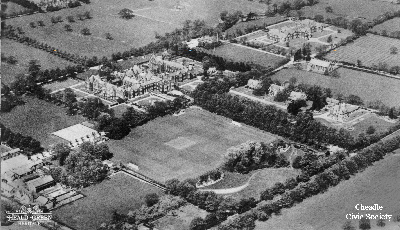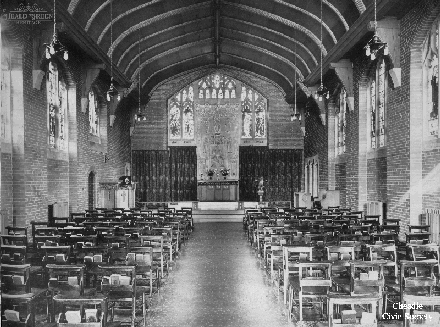top of page
Cheadle Royal Hospital
Origins by John Davies

First Published 18/10/2021
Last Updated 11/1/2022
In this excellent piece, first published on the We Grew Up in Manchester Facebook page, John Davies
describes how the "Manchester Lunatic Hospital" came to move to Heald Green from central Manchester
Fig. 1a Lunatic Hospital (to left), Manchester Royal
Infirmary (to right), Piccadilly Gardens, 18th Century
© Manchester Libraries
Click On Image To View
In days of old, mental illness was seen as a family problem, something to be ashamed of and best hidden away. “Lunatics” were often sent to isolated communities, put in monastic hospitals, or boarded out to be looked after privately. If a person was considered really disturbed or violent, the parish authorities might put them in a “house of correction” or workhouse. From the late 17th century, there was an increase in privately run and charitable “lunatic asylums”.
In the 18th century, there was growing concern in the Manchester area about the abuses of private “madhouses”. In 1752, the original Manchester Royal Infirmary was built on the site of present-day Piccadilly Gardens. It treated people suffering from mental illness, but only as out-patients. Therefore in 1766, one of the first lunatic asylums in Britain, the “Manchester Lunatic Hospital” was built adjoining it.
The Lunatic Hospital was originally part of the Manchester Infirmary. It was governed by a board of trustees appointed by the MRI trustees, but the hospital was financially independent. The law at the time didn’t require the family to get a medical certificate for committing someone to the hospital, but at Piccadilly, they only admitted patients with an order signed by a physician and four of the trustees. Also, unlike other voluntary hospitals, the hospital required payment for patients. This helped the hospital to be financially independent and avoided some of the difficulties which charitable hospital had in raising funds. Patients were paid for either by their family or by poor law authorities.
It is described as originally having 24 “cells” for patients, but appears to have been founded in a genuine spirit of humanity, probably aiming to avoid the terrible treatment found at many other private institutions at the time. Perhaps because patients were being paid for, there was a tradition of patients' rights and physicians and apothecaries regularly attended and kept medical records. In 1773, the trustees passed a resolution stating that there would be “No stripes or beatings. No painful coercion whatsoever, more than what is necessary to restrain them from hurting themselves or others”.
The hospital expanded rapidly. By 1787, it had more patients than the main infirmary next door and by 1800 it had over 100 beds. Nearly 50 years later the trustees were still praising the original founders of the hospital for their “…mild, merciful and enlightened measures…”, adding that, "Kindness and tenderness soothe and heal the bruised mind and affrighted imagination."
By the mid-19th century, Victorian Manchester was growing quickly. The Piccadilly site, which had once been on the edge of the town, was now becoming built up and noisy, making it unsuitable for the care of patients with mental illness. So in 1845, the trustees bought a site in Cheadle [Ed: In Heald Green] and the hospital moved there four years later (it was officially named “The Manchester Royal Hospital for the Insane*”).
After the Lunatic Hospital moved to Heald Green, the building at Piccadilly was demolished and the infirmary was re-modelled and enlarged. The Manchester Royal Infirmary relocated to its current site on Oxford Road in 1908. The hospital buildings in Piccadilly were then completely demolished by April 1910 apart from the outpatients department, which continued to deal with minor injuries and dispense medication on this site until the 1930s.
Fig. 1c Ornamental Pond, Piccadilly Gardens, 18th Century
© Ancestry Images.com
Click On Image To View
Fig. 1b Map of Piccadilly Gardens, 1844
© Manchester Libraries
Click On Image To View
[*Ed. The nickname "Cheadle Royal" soon became common parlance for the Hospital for the Insane, as that was the nearest railway station at the time. Heald Green station was not built until much later, in 1909.]
Cheadle Royal Hospital
Introduction by Colin Barnsley

First Published 14/5/2021
Last Updated 11/1/2022
If the railway made Heald Green, Cheadle Royal Hospital made Long Lane. This excellent booklet from the 1960s provides the historical background, and more information and wonderful pictures can be found on Cheadle Civic Society's pages.
Richard Fletcher has kindly shared a short piece with us below, regarding the former chapel and its beautiful stained glass windows.
1
Fig. 2a Cheadle Royal Hospital, 1920s
© Cheadle Civic Society
Click On Image To View
Fig. 2b Cheadle Royal Hospital 2019
© Richard Fletcher
Click On Image To View
Fig. 2c Cheadle Royal Hospital From Above, 1920s
© Cheadle Civic Society
Click On Image To View
Fig. 2d Cheadle Royal Hospital 2021
© Colin Barnsley
Click On Image To View
Cheadle Royal Chapel
By Richard Fletcher

First Published 18/5/2021
Last Updated 11/1/2022
This is a building that still stands but is used for non-religious purposes. It was designed by Percy Scott Worthington and built in 1904 as a chapel for the use of and in the grounds of Cheadle Royal Mental Hospital. The main hospital buildings were designed in 1848 by the architect Richard Lane. The chapel seated 200 and comprised an entrance porch and ante-chapel divided from the main chapel by an oak screen with an organ-loft above. The reredos was by Harry Malcolm Miller of Messrs Earp, Hobbs and Miller of Manchester and carved in situ from stone which formed part of the wall.
Fig. 3a Cheadle Royal Chapel, 2019
© Richard Fletcher
Click On Image To View
Fig. 3b Inside Cheadle Royal Chapel, 1920s
© Cheadle Civic Society
Click On Image To View
Between 1906 and 1915 a spectacular set of stained-glass windows by Morris & Co was installed, comprising a 4-light east window, a 3-light west window and five 3-light windows on each of the north and south sides. After the hospital was acquired by Affinity Healthcare in 2001, the chapel was deconsecrated and used for offices. All the windows, apart from those at the east end, were bought by the Kensington antique dealers Haslam and Whiteway, who featured them in a special exhibition in 2008. A detailed catalogue was written by the stained-glass expert Peter Cormack.
2
Fig. 3c Stained Glass from Cheadle Royal Chapel
© Peter Cormack 2008
Click On Image To View
In 2009, six of the windows were bought by Stockport Heritage Services with money from the Art Fund, and the remainder were sold to various buyers. The whole site, including the chapel, now belongs to the Priory Group, providers of mental health care.
Bibliography
-
Unknown (1966). Cheadle Royal Hospital Leaflet.
-
Cormack, P (2008). Morris and Company's Stained Glass for the Chapel of Cheadle Royal Hospital. : Haslam & Whiteway Ltd.
Related Links
-
Percy Worthington - Wikipedia
-
Richard Lane (architect) - Wikipedia
-
Harry Malcolm Miller - Mapping the Practice and Profession of Sculpture in Britain and Ireland 1851-1951 (gla.ac.uk)
-
Manchester Royal Infirmary - Wikipedia
-
Piccadilly Gardens - Wikipedia
-
Oxford Road, Manchester - Wikipedia
-
Archive and local collections - Photographs and posters | Manchester City Council
-
Ancestry Images.com
-
Williams, K & Williams, J.T (1998). Long Lane Cheadle Remembered.
-
Cheadle & Gatley Civic Society
-
Lost Churches in the UK Outside London Facebook Page
-
Stockport Heritage Services
-
The Priory Hospital, Cheadle
Timeline
Search Our Museum Library (Google Drive account users only)
Can You Help Us Improve The Museum?
-
Do you have any related personal memories, photos or documents that you can share with us on this topic?
-
Are any of our facts incorrect?
-
Contact us at healdgreenheritage@gmail.com, or via our Heald Green Heritage Facebook Page.
bottom of page















